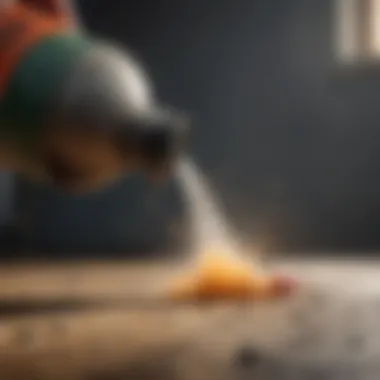Mastering Indoor Pest Control: The Ultimate Bug Bomb Guide


Preventive Pest Control Strategies
House Exterior Protection When it comes to effective pest control, focusing on preventive measures is key to maintaining a pest-free indoor environment. House exterior protection plays a crucial role in keeping pests at bay. Tips for sealing cracks - Inspecting and sealing any cracks or gaps in your home's exterior can prevent pests from finding their way inside. Clearing debris - Regularly removing debris around the exterior of your house eliminates potential hiding spots for pests. Preventing pests from entering - Implementing barriers like screens on windows and doors can deter pests from entering your home. Yard Maintenance Proper yard maintenance not only enhances the aesthetics of your outdoor space but also helps in preventing pest infestations. Essential yard care routines - Regular mowing, trimming shrubs, and removing standing water sources can deter pests from breeding in your yard. Methods for keeping yard pest-free - Using natural pest repellents like neem oil or planting pest-repelling plants can help in maintaining a pest-free yard. Indoor Cleanliness Maintaining a clean indoor environment is essential for preventing pest infestations. Expert cleaning tips and techniques - Regularly vacuuming, dusting, and decluttering can eliminate hiding spots for pests. Maintaining a pest-resistant indoor environment - Proper storage of food, sealing food containers, and fixing any moisture issues can make your home less attractive to pests. Garbage Disposal Efficient waste disposal methods are critical in preventing pest infestations. Importance of proper garbage disposal - Ensuring trash bins have secure lids and taking out the trash regularly can reduce the likelihood of attracting pests to your property. Other Pest Prevention Strategies In addition to the mentioned strategies, there are innovative ways to safeguard your home against pests. Implementing natural barriers like diatomaceous earth, using sound devices to deter pests, or seeking professional pest control services can further enhance your pest prevention efforts.
Identifying Pest Risk Areas
Moisture Prone Areas Inspection Moisture-prone areas in your home are attractive to pests like termites and cockroaches. Identifying damp conditions - Checking areas prone to moisture such as basements, bathrooms, and kitchens for leaks or water damage can help in early detection and prevention of pest infestations. Tips for preventing infestations - Fixing leaks, improving ventilation, and using dehumidifiers can create a less hospitable environment for pests. Crack and Crevice Inspection Guide Cracks and crevices in your home serve as entry points for pests. Importance of inspecting access points - Regularly inspecting baseboards, windows, and doors for cracks and sealing them with caulk or weatherstripping can prevent pests from entering. Strategies for sealing cracks and crevices - Using sealants like silicone or expanding foam can help in closing off potential entry points for pests. Greenery Inspection for Pest Risks Greenery around your home can harbor pests like ants or outdoor rodents. Understanding greenery's impact on pests - Overgrown bushes or trees close to your home can provide pests with easy access indoors. Guidelines to maintain pest-free yards - Pruning vegetation away from your house and keeping mulch and plants well-maintained can reduce the chances of pest infestations. Additional Pest Risk Areas It's essential to identify and address miscellaneous pest risk areas in and around your property. Checking areas like attics, crawl spaces, and utility rooms, and implementing preventive measures such as using screens on vents and maintaining proper insulation can help in mitigating pest risks.
Introduction
Indoor pest control is a critical aspect of maintaining a clean and hygienic living environment. In this article, we delve into the intricacies of using bug bombs effectively to tackle indoor pest infestations. As pests can pose health risks and compromise the quality of indoor spaces, understanding and implementing efficient pest control measures is paramount to creating a safe and comfortable living environment. This comprehensive guide will provide detailed insights into the preparation, execution, and post-bombing considerations necessary for successful indoor bug bomb usage.
Understanding Indoor Pest Control
Common Indoor Pests
When it comes to indoor pest control, common pests such as cockroaches, ants, and flies are prevalent nuisances that can infiltrate homes unnoticed. These pests are attracted to food sources and conducive environments, making kitchens and living spaces their ideal habitats. Understanding the behavior and biology of common indoor pests is crucial in devising effective pest control strategies. By targeting their entry points and breeding grounds, we can mitigate infestations and prevent future occurrences.
Health Risks Associated with Pests
Indoor pests not only disrupt living spaces but also pose significant health risks to occupants. Pests can carry diseases, trigger allergies, and contaminate food, compromising the overall health and well-being of individuals. Proper pest control measures, including the use of bug bombs, play a pivotal role in safeguarding against the health hazards associated with indoor pests. By eradicating pests effectively, we can create a safer and healthier indoor environment for ourselves and our families.
Role of Bug Bombs in Pest Control
Bug bombs serve as powerful tools in combating indoor pest infestations by dispersing insecticidal compounds throughout treated areas. These foggers are designed to penetrate crevices, cracks, and hidden spaces, targeting pests where conventional methods may fall short. Understanding the strategic role of bug bombs in pest control allows homeowners to effectively manage infestations and maintain pest-free environments. While bug bombs offer a convenient solution, proper usage and precautions are crucial to ensuring successful pest eradication without compromising indoor safety.
Overview of Bug Bombs
Composition and Function
Bug bombs consist of insecticides that are formulated to target specific pests commonly found in indoor environments. The composition of bug bombs is engineered to release insecticidal fumes that penetrate nooks and crannies, reaching pests hidden in inaccessible areas. Understanding the chemical makeup and functionality of bug bombs is essential in maximizing their efficiency and efficacy in eradicating indoor pests.
Types of Bug Bombs
There are different types of bug bombs available in the market, each catering to specific pest control needs and indoor environments. From aerosol sprays to total release foggers, the variety of bug bombs offers homeowners flexibility in choosing the most suitable option for their pest infestation. By selecting the appropriate type of bug bomb based on the pest species and infestation severity, individuals can effectively address indoor pest problems and prevent recurring issues.


Safety Concerns and Precautions
While bug bombs are effective in controlling pests, they also come with safety considerations that must be adhered to during application. Proper ventilation, safety gear, and evacuation plans are imperative to minimize the risk of chemical exposure and ensure the well-being of occupants. Understanding the safety concerns and precautions associated with bug bombs is essential for a hassle-free and secure pest control experience. By following recommended safety practices, homeowners can effectively utilize bug bombs without compromising indoor air quality or personal health.
Preparation for Bug Bombing
Preparation for bug bombing is a critical aspect of ensuring the effectiveness of indoor pest control measures. In this article, we delve deep into the importance of meticulous preparation before initiating bug bombing in indoor spaces. By focusing on specific elements such as proper planning, organization, and attention to detail, readers will gain a comprehensive understanding of why thorough preparation is key to successful bug bomb usage in eradicating indoor pests.
Identifying Target Areas
Inspection of Infestation
Inspection of infestation stands as a cornerstone in the preparation phase for bug bombing. This crucial step involves meticulously examining indoor spaces to pinpoint areas heavily infested by pests. By conducting a thorough inspection, individuals can identify the severity of the infestation, the type of pests present, and the most affected areas. This detailed scrutiny not only aids in determining the extent of the issue but also helps in strategizing the most effective course of action for bug bombing. The inspection process serves as a fundamental tool in creating targeted treatment plans based on specific pest behavior and localization within the indoor environment.
Determining Treatment Zones
With the information gathered from the inspection process, determining treatment zones is the next pivotal step in preparation for bug bombing. This involves segregating indoor spaces into distinct zones based on the severity of the infestation and the type of pests identified. By delineating treatment zones, individuals can allocate resources efficiently, ensuring that bug bombs are strategically placed in areas where pests are most prevalent. The segmentation of treatment zones enables a systematic approach to pest control, maximizing the effectiveness of bug bombing while minimizing chemical exposure in unaffected areas. Establishing treatment zones is essential for creating a focused and targeted bug bombing strategy tailored to tackle specific pest-infested areas within indoor environments.
Securing the Space
Covering Food and Utensils
One crucial aspect of securing the space before bug bombing is ensuring the protection of food and utensils. Covering food items and utensils shields them from potential contamination by bug bomb residues, safeguarding the health and well-being of occupants. This precautionary measure prevents chemical exposure and maintains the hygiene and safety standards of food items within the treated premises. By securely covering food and utensils, individuals can prevent any adverse effects of bug bombing chemicals on consumables, enhancing overall safety during and after the pest control process.
Protecting Electronics and Valuables
Another vital consideration when securing the space for bug bombing is the protection of electronics and valuables. Shielding electronic devices and valuables from bug bomb chemicals is essential to prevent damage or malfunction caused by exposure to the substances emitted during the treatment. By safeguarding electronics and valuables in sealed containers or covering them with protective materials, individuals can mitigate the risk of corrosion or other harmful effects of pest control chemicals. This proactive measure ensures the preservation of valuable possessions and the uninterrupted operation of electronic equipment post bug bombing, emphasizing the importance of thoughtful protection strategies in securing the indoor environment.
Safety Measures
Use of Protective Gear
The utilization of protective gear is a pivotal safety measure during bug bombing procedures. Wearing appropriate protective gear such as masks, gloves, and eye protection shields individuals from direct contact with bug bomb chemicals, reducing the risk of chemical exposure and associated health hazards. Protective gear acts as a barrier, safeguarding against potential respiratory and dermal reactions to the active ingredients in bug bombs. By adhering to safety protocols and donning protective gear, individuals can ensure their well-being and minimize any adverse effects of exposure to pest control chemicals during the bug bombing process.
Evacuation Plan
Having a well-defined evacuation plan is imperative for ensuring the safety of occupants during bug bombing activities. An evacuation plan outlines the procedure for temporarily vacating the treated premises to avoid direct exposure to bug bomb fumes and residues. By planning ahead and designating evacuation routes and meeting points, individuals can efficiently evacuate indoor spaces, reducing the risk of inhalation or skin contact with pesticide residues. Implementing a comprehensive evacuation plan is essential for prioritizing occupant safety and mitigating potential health risks associated with bug bomb usage, underscoring the significance of proactive safety measures in indoor pest control practices.


Execution of Bug Bombing
In the realm of indoor pest control, the execution of bug bombing stands out as a pivotal stage for effectively eradicating pests from indoor spaces. The process of deploying bug bombs is not merely about setting and forgetting; it requires a nuanced understanding of various elements to ensure optimal results. The importance of the execution phase in bug bombing cannot be overstated, as it dictates the efficacy and success of the entire pest control operation. By delving into specific considerations and meticulous planning during the execution phase, individuals can maximize the impact of bug bombing for a pest-free environment.
Activating the Bug Bomb
Proper Placement of Bug Bombs
Proper placement of bug bombs plays a critical role in the success of the bug bombing process. It involves strategically positioning bug bombs in areas most susceptible to pest infestations, ensuring comprehensive coverage and maximum effectiveness. The key characteristic of proper placement lies in targeting areas with high pest activity or known harborage sites. This strategic approach not only optimizes the distribution of the insecticide but also increases the likelihood of eliminating pests efficiently. However, improper placement can result in subpar outcomes, leaving certain areas untreated and allowing pests to persist. Therefore, meticulous attention to detail in the placement of bug bombs is essential for achieving desired pest control results.
Activation Process
The activation process of bug bombs is a crucial step that initiates the dispersal of insecticidal fog into the targeted spaces. This process typically involves activating the release mechanism on the bug bomb, allowing the insecticide to permeate the area and reach hidden crevices where pests may be hiding. One key characteristic of the activation process is its simplicity and ease of use, making it accessible to individuals seeking a convenient pest control solution. However, it is essential to follow manufacturer instructions meticulously to ensure safe and effective activation of the bug bomb. While the activation process is user-friendly, overlooking specific steps or guidelines can compromise its efficiency, leading to suboptimal pest control outcomes. Therefore, thorough understanding and adherence to the activation process are imperative for successful bug bombing in indoor environments.
Timer Settings
Setting the timer on bug bombs is a critical aspect that determines the duration of insecticidal fog dispersion and exposure time. The key characteristic of timer settings lies in regulating the release of insecticide within a specified timeframe to achieve desired pest control outcomes. Properly adjusting the timer ensures sufficient exposure of insecticidal fog to target pests while minimizing potential risks of overexposure or chemical residues. However, inaccurate timer settings can impact the efficacy of bug bombing, either by insufficiently treating the area or prolonging exposure beyond necessary limits. Thus, careful consideration of timer settings based on the size of the space, concentration of pests, and manufacturer recommendations is vital for optimizing bug bombing results.
Monitoring and Ventilation
Monitoring Exposure Time
Monitoring exposure time during bug bombing is essential to control the level of insecticide dispersion and minimize potential risks associated with prolonged exposure. The key characteristic of monitoring exposure time is to regulate the duration of bug bombing based on factors such as the size of the space, product potency, and pest severity. This proactive approach allows individuals to ensure effective pest control while safeguarding against excessive chemical exposure. While monitoring exposure time is a straightforward process, neglecting this aspect can result in either under-treatment of pests or unnecessary chemical exposure in indoor environments. Therefore, vigilant monitoring of exposure time is paramount for achieving optimal bug bombing outcomes.
Ventilation Procedures
Implementing proper ventilation procedures post-bug bombing is crucial to facilitate air circulation and dissipate residual chemicals from indoor spaces. The key characteristic of ventilation procedures lies in promoting the airflow to expel lingering insecticidal fog and minimize occupants' exposure to chemical residues. Effective ventilation not only accelerates the clearance of pollutants but also enhances overall indoor air quality for a safe and healthy environment. However, inadequate ventilation can lead to extended chemical retention, posing potential health risks and discomfort to occupants. Thus, following recommended ventilation strategies, such as opening windows, using fans, and allowing fresh air circulation, is essential after bug bombing to promote a conducive indoor atmosphere.
Aftermath and Cleanup
Returning to Treated Area
Returning to the treated area after bug bombing requires caution and adherence to safety guidelines to prevent exposure to residual chemicals. The key characteristic of returning to the treated area involves waiting for the recommended duration before re-entry to ensure chemical dissipation and minimize health risks. This precautionary measure aims to safeguard individuals from potential chemical residues while allowing the insecticide to complete its pest control action. However, premature re-entry or neglecting guidelines for returning to the treated area can jeopardize both effectiveness and safety, compromising the pest control results and occupants' well-being. Therefore, respecting the specified re-entry time is imperative for a successful bug bombing experience.
Cleaning Residual Chemicals
Cleaning residual chemicals post-bug bombing is essential to eliminate any remaining traces of insecticide and restore the treated area to a safe and habitable condition. The key characteristic of cleaning residual chemicals involves employing appropriate cleaning agents and techniques to remove chemical residues effectively. This process not only enhances the aesthetic appeal of the space but also mitigates potential risks of prolonged chemical exposure to occupants. Failing to address residual chemicals through thorough cleaning can lead to persistent chemical traces, hindering occupants' comfort and safety. Therefore, meticulous attention to detail in cleaning residual chemicals is paramount for achieving a harmonious post-bug bombing environment.


Post-Bombing Considerations
In the aftermath of utilizing bug bombs indoors, post-bombing considerations play a crucial role in ensuring the effectiveness of the treatment. This section delves deep into evaluating the success of the bug bombing process and understanding its implications for future pest control strategies. Post-bombing considerations encompass a range of elements that are vital to maintaining a pest-free environment. By carefully assessing the aftermath of a bug bombing operation, homeowners can gauge the efficacy of the treatment and determine if further steps are required to address any residual pest issues.
Effectiveness Evaluation
Assessing Pest Activity Post-Treatment
Assessing Pest Activity Post-Treatment is a pivotal step in the bug bombing process as it allows individuals to ascertain the impact of the treatment on indoor pests. This careful evaluation involves observing the level of pest activity in the treated areas and noting any changes post-bombing. Understanding how pests react to the bug bombing aids in refining future pest control measures and adapting strategies to suit specific infestation needs. The methodical assessment provided by this evaluation sheds light on the effectiveness of bug bombing as a control method and guides further pest management decisions.
Additional Steps if Needed
Sometimes, despite the initial bug bombing treatment, additional steps may be necessary to address persistent pest issues effectively. This could involve targeted localized treatments, increased sanitation measures, or seeking professional pest control assistance. Identifying when supplementary action is required is key to preventing reinfestation and maintaining a pest-free indoor environment. By being proactive and ready to take additional steps if needed, homeowners can enhance the overall efficacy of their pest control efforts.
Health and Environmental Impact
Residual Chemical Exposure
Residual Chemical Exposure is a critical aspect to consider after bug bombing, as it pertains to the potential lingering effects of the insecticide used in the treatment. Understanding the level of residual chemical exposure post-bombing is essential for ensuring the safety of occupants, especially vulnerable individuals such as children or pets. Minimizing residual chemical exposure through proper ventilation and post-bombing cleanup is vital for safeguarding indoor air quality and preventing health risks associated with prolonged chemical exposure.
Environmental Disposal of Empty Cans
Proper disposal of empty bug bomb cans is a key component of responsible pest control practices. Environmental Disposal of Empty Cans involves adhering to local regulations for the disposal of used insecticide containers to prevent environmental contamination. Recycling options or hazardous waste disposal guidelines should be followed to minimize the ecological footprint of bug bombing activities. By prioritizing environmentally-friendly disposal methods, homeowners can contribute to sustainable pest control practices and reduce the impact of insecticide residues on surrounding ecosystems.
Conclusion
In the realm of indoor pest control, the conclusion serves as a pivotal segment encapsulating the essence and significance of effective bug bomb usage. It consolidates every preceding detail and guideline into a tangible outcome for ensuring a pest-free indoor environment. Delving into the conclusive phase of bug bomb usage unveils a realm of benefits and considerations crucial for the optimal execution of pest control strategies.
Summary of Key Points
Importance of Proper Bug Bomb Usage
The importance of proper bug bomb usage fundamentally anchors on the meticulous application of these pest control measures for optimal results. Emphasizing the strategic deployment of bug bombs within indoor spaces ensures the eradication of pests effectively. The key characteristic of proper bug bomb usage lies in its targeted approach, specifically tailored to eradicate pests while safeguarding indoor environments from infestations. This approach proves to be a popular choice for individuals seeking a comprehensive and swift solution to pest issues within their living spaces. The unique feature of proper bug bomb usage is its efficiency in eliminating pests promptly, although it necessitates strict adherence to safety regulations and guidelines for maximum effectiveness.
Maintenance of Pest-Free Environment
Maintaining a pest-free environment post bug bomb usage is quintessential in upholding the efficacy of pest control measures. The meticulous maintenance of a pest-free indoor space is instrumental in preventing reinfestation and ensuring long-term protection against pests. The key characteristic of maintaining a pest-free environment involves consistent vigilance and adherence to cleanliness practices that deter pests from re-entering treated areas. This aspect is a popular choice as it offers a sustainable solution to pest management, promoting a healthy and hygienic living environment. The unique feature of maintaining a pest-free environment is its ability to prolong the effects of bug bomb treatments, providing long-lasting protection against various indoor pests while minimizing the risk of future infestations.
Final Thoughts
Appreciating the Role of Indoor Pest Control
Appreciating the pivotal role of indoor pest control signifies acknowledging the essentiality of proactive pest management in safeguarding indoor spaces. Understanding the significance of indoor pest control underscores the significance of preventive measures in mitigating pest-related risks and preserving the sanctity of living environments. The key characteristic of appreciating the role of indoor pest control lies in its proactive nature, prioritizing prevention over remediation to ensure persistent pest-free conditions within indoor spaces. This notion stands as a popular choice among individuals seeking comprehensive and sustainable solutions to pest control, integrating long-term strategies that address pest issues at the root. The unique feature of appreciating the role of indoor pest control is its versatility in adapting to varying pest challenges, thus offering adaptability and resilience in maintaining pest-free indoor environments.



